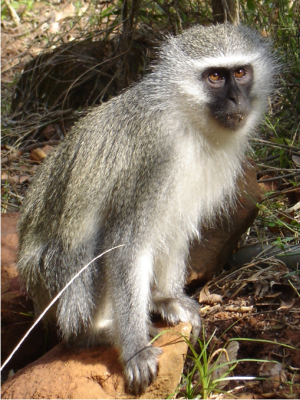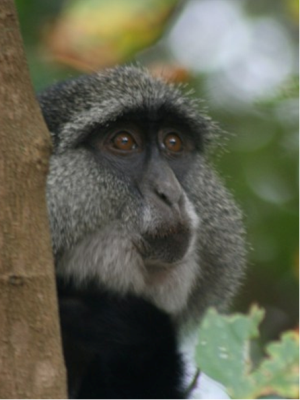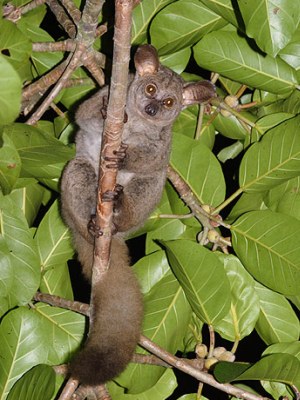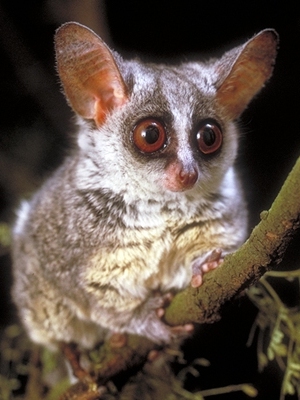Primates
Go to:
Return to:
Department of Anthropology
Durham University
Dawson Building
South Road
Durham DH1 3LE
UK
Tel: +44 (0) 191 334 1601
Fax: +44 (0) 191 334 1614
[email protected]
Last updated
15th January 2021

We are fortunate that Lajuma supports an abundance of all five species of South African primate: chacma baboon, Papio ursinus; vervet monkey, Cercopithcus aethiops; samango monkey, Cercopithecus mitis erythrarchcus; thick-tailed bushbaby, Otolemur crassicaudatus; and lesser bushbaby, Galago moholi.
 |
Chacma baboon Papio ursinus Although there is some disagreement about whether they are full species or subspecies, five species of baboons have traditionally been recognised with the chacma baboon (Papio ursinus) found in southern Africa from South Africa and north to Angola, Zambia, and Mozambique. Chacma baboons usually live in social groups composed of multiple adult males, adult females, and their offspring that can range in size from 10 to 120 individuals. Small groups may include only a single adult male. Chacma baboon groups are characterized by a dominance hierarchy. Female ranking within the troop is inherited through the mother and remains quite fixed, while male ranking is often in flux, especially when the dominant male is replaced. Males are considerably larger than females (males: 25–30 kg; females 14-16 kg) and so outrank them in the hierarchy. Chacma baboons are diurnal and predominantly terrestrial and inhabit a wide array of habitats, from grassy alpine slopes to the semi-desert habitats, although they are mostly encountered in woodland and savanna-type habitats. Their habitat flexibility is also reflected in their diet; chacma baboons are omnivorous with a preference for fruits, while also eating insects, seeds, grass and smaller vertebrate animals. At Lajuma, chacma baboon regularly predate upon vervet monkeys. |
 |
Vervet monkey Cercopithecus aethiops The vervet monkey (Cercopithecus aethiops) is an opportunistic omnivorous primate with a flexible behavioural repertoire, which enables it to occur throughout most of sub-Saharan Africa (although it is generally absent from deserts and tropical rainforests). Animals are active during daylight hours and maintain a semi-terrestrial, semi-arboreal lifestyle, which, combined with a relatively small body size (males: 4–8 kg; females 3–5 kg), renders them susceptible to predation by a wide range of mammalian, avian and reptilian predators. As a result, vervet monkeys have evolved distinct behavioral responses to the various predators they encounter, with predator-specific alarm calls eliciting adaptive behavioral responses. Multi-male multi-female groups, typically of around 20 individuals, occupy stable home ranges that may overlap to varying degrees. Vervet monkeys eat a wide range of fruits, figs, leaves, seeds and flowers, and also include some animal matter in their diet; vervets have been observed to eat birds’ eggs and young chicks as well as insects such as grasshoppers and termites. |
 |
Samango monkey Cercopithecus mitis erythrarchus Samango monkeys (Cercopithecus mitis erythrarchcus), also known as Sykes’ or blue monkeys in parts of their range, are medium sized, diurnal, arboreal guenons with an average adult female weight of approximately 4.4 kg and adult male weight of approximately 7.6 kg. Samango monkeys form single-male groups with group sizes ranging from 4-65, although it is not uncommon for groups to have more than one resident male. During the breeding season the number of males in a group can increase significantly. The diet of samango monkeys includes fruits, insects, flowers, leaves and insects. Although C.mitis is distributed throughout much of central and east Africa, the South African sub-species are at the southern extremes of their range and confined to the larger forest blocks, usually greater than 300 ha in extent. Like vervet monkeys, samango monkeys are also known to give acoustically distinct alarm calls for different types of predator.
|
 |
Thick-tailed bushbabies Otolemur crassicaudatus Thick-tailed bushbabies (Otolemur crassicaudatus) are the largest of the bushbabies (males 1.5kg, females 1.25kg). They are mostly found in riparian and coastal forest, although their distribution extends into bushland and open woodland in parts of its range. They are nocturnal and feed upon gums and/or fruit, although seeds, nectar, insects and other animal matter may also form part of the diet. Unlike other galagines, this species moves quadrupedally through the forest and bush, and may move up to 1km per night. Adult males are territorial and they seek home ranges that overlap several female home ranges. Thick-tailed bushbabies may sleep alone or in groups of 2-6 and generally disperse solitarily or in small groups at night to forage. The species communicates using a variety of vocalizations, incluing loud cries, barks, and a high-pitched alarm call. Olfactory signals are also important in thick-tailed bushbabies, with chest gland marking and urine washing potentially used to comminicate territoriality, dominance or sexual status.
|
 |
Southern lesser bushbabies Galago moholi Southern lesser bushbabies (Galago moholi) are small nocturnal primates (males 160-255g, females 140-229g) that inhabit semi-arid woodlands, savanna woodlands, gallery forests, and the edges of wooded areas. They are often associated with Acacia trees, the exudates of which are a dietary staple, although invertebrates such as butterflies, moths and beetles also comprise a significant proportion of the diet. Southern lesser bushbabies live in small social groups. They can be found sleeping in groups of 2 to 7 during the day, typically comprised of a female and several of her young. At night the groups separate to forage independently. Female territories average 6-7ha, with dominant males having territories which overlap with those of several females. Bushbabies can communicate over long distances using loud calls that are thought to maintain contact within a group, advertise territory status, or serve as an alarm call. Bushbabies also employ olfactory modes of communication by “urine washing” their hands and feet, a behaviour that is more common in dominant males. It is also possible that the urine on the foot pads helps them to grip branches more easily; bushbabies are accomplished leapers, sometimes covering many metres as the leap between trees and move around their arboreal environment. |

